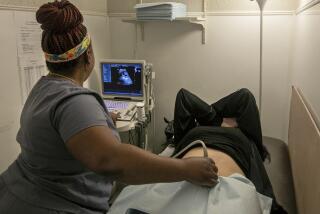Delaying Breast Biopsy May Be a Poor Strategy
- Share via
When a mammogram reveals a highly suspicious area, a biopsy is done quickly to determine if it’s malignant. But when there’s a subtle abnormality, the doctor may say, “Come back in six months and we’ll take another look.” If it is cancer, that six months may be too long to wait.
A study of 4,465 Canadian women with breast cancer found that delaying diagnosis for more than 20 weeks after abnormal screening tests worsens prognostic factors like tumor size and lymph node involvement. The screening exams included a mammogram and a clinical breast exam. In six months to a year, this study showed, a cancer is likely to be larger than 10 millimeters. And the longer the wait, the greater the risk that the cancer will have spread to the lymph nodes.
In some cases there was as much as a three-year delay. That’s the kind of waiting game that women with breast cancer inevitably lose. It’s not necessary to do a biopsy on everyone with an abnormal screening, but lead researcher Ivo A. Olivotto, of the Screening Mammography Program at the British Columbia Cancer Agency in Victoria, says, “If the radiologist is iffy, a biopsy is worthwhile. A delay of six to 12 months can make a difference.” (Cancer, 94: 8; 2,143-2,150)
*
Inhaled Asthma Drug Is Cheaper, Effective Therapy
It’s good news when a study shows that the first choice in treatment is also the least expensive. An analysis of insurance claims for 781 people with asthma revealed that those taking fluticasone propionate (Flovent), an inhaled corticosteroid, had lower medical costs than those taking the oral leukotriene modifiers, montelukast (Singulair) or zafirlukast (Accolate).
The costs, tracked over a nine-month period, included the price of the medication and all medical care associated with the illness. All of the drugs work by decreasing inflammation in the lungs, but inhaled corticosteroids were recommended as the first choice for mild and moderate persistent asthma by the National Asthma Education and Prevention Program in 1997. Since then several clinical trials have shown that the inhaled drugs are more effective than leukotriene modifiers, according to an editorial accompanying the study by University of Florida Health Center authors.
“This analysis of all the costs of care ... points in one direction: [Flovent] is the most cost-effective in general,” said Dev Pathak, professor of pharmacy at Ohio State University. (Pharmacotherapy 2002: 22(2) 131-133 and 166-174)
*
Exercise-Free Method of Building Muscle in the Works
Wouldn’t it be nice to spend your evenings watching TV or reading and still build fit muscles? That fantasy may one day be a reality thanks to the recent discovery in animal studies that muscle fibers can be transformed without exercise into the oxygen-burning, energizing type that are the pride of marathon runners.
For about 10 years scientists have been studying the chemical signals that turn muscle fibers that tire easily into fatigue-resistant ones. One signal that aerobic exercise triggers is an enzyme that produces more mitochondria, which are cells’ energy factories. Now researchers have genetically engineered mice in which the enzyme is always turned on. “We found that the muscles of these animals were transformed. They had several changes that are the same that you see with exercise,” said Rhonda Bassel-Duby, associate professor of internal medicine at the University of Texas Southwestern in Dallas.
Unlike these genetically engineered mice, people need to sustain the muscle transforming signals to stay fit. “One reason you lose your endurance when you stop an exercise program is that the genetic programming in your muscles swings back,” said Bassel-Duby. Developing a drug that will override our programming is the ultimate goal, but couch potatoes are not likely to be the first to benefit. Rather, Bassel-Duby said, she hopes it will help people with serious conditions like heart failure be able to get up and start walking. (Science, 296 (5566); 349-352)
*
‘Expectant Management’ a Possible Option After Miscarriage
About 15% of pregnancies end abruptly in the first 12 weeks. It’s a sad time, and women who have had an incomplete miscarriage often have the remaining tissue from the pregnancy surgically removed promptly. That’s yet another trauma, and though complications of a D&C;, or dilatation and curettage, are rare, they happen.
Some obstetricians think women should be offered another choice, called “expectant management,” meaning the woman waits for a while to see if the tissue will be lost naturally. A recent study of 478 women in Great Britain who had early miscarriages but retained some of the tissue found that 81% completed the miscarriage spontaneously, about half of them within a week. Ultrasound was a valuable tool in determining which women could undergo “expectant management” and monitoring their progress. The St. George’s Hospital research team in London writes that more studies on the use of ultrasonography for this purpose are needed. Expectant management is not unusual in the United States, and women should be offered the option and informed about the risks of bleeding and infection, said Alan DeCherney, professor of obstetrics at UCLA Medical Center.
The results of this study are consistent with the U.S. experience, DeCherney says. “Most women can be handled expectantly, but they shouldn’t wait more than two weeks because problems can occur.” (British Medical Journal 2002: 324; 873-875)
*
Hormone Shampoos May Contribute to Precocious Puberty
Are parents inadvertently putting their children on hormone therapy just by caring for their hair? According to a report in the British science journal New Scientist, there are at least five companies making hormone-containing hair care products, and questions have been raised about whether exposure to the estrogen in them might trigger premature sexual development in girls.
Several years ago, one pediatrician reported that long-term exposure to estrogen-containing hair care products could be responsible for precocious puberty. Chandra Tiwary, who was chief of pediatric endocrinology at the Brooke Army Medical Center in Texas at the time, found that when the estrogen-containing products were no longer used in four young children with this condition, breast development and pubic hair growth regressed in three of them.
Medical causes of early puberty had already been ruled out. But an anecdotal report like Tiwary’s is not proof of an association, and thus far no scientific studies have been published.
Estrogen can be absorbed through the scalp easily, says Herbert Burack, a pharmacist who specializes in dermatologic compounding at Orentreich Medical Group in New York City. “The scalp has a large surface area; it’s like a sieve. From there estrogen can easily get into the bloodstream,” he said.
Meanwhile, products like BB Super Gro are still sold. According to a recent survey of 130 people at three Seattle clinics, one in five used hormone-containing hair products, and 85% of them used the same products on their children. Nearly half of the users were African American.
*
Dianne Partie Lange can be reached by e-mail at diannelange@cs.com.






